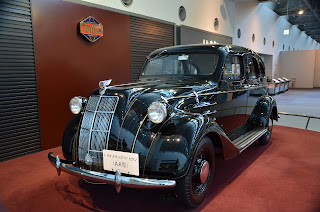VANCOUVER INTERNATIONAL AUTO SHOW 2011
The launch of the 2011 Vancouver International Auto Show - held for the first time at the Vancouver Convention Center - was reflective of the current Canadian economy: subdued but cautiously optimistic. The show runs through to Sunday, April 3, 2011 and as with past events, expect the weekend to be packed with car enthusiasts of all ages.
The manufacturers have reasons to be buoyant, thanks to healthy gains in sales fueled by new as well as significantly refreshed models. On one hand, the theme of some models was very much focused on horsepower and performance - to feed the adrenaline seekers. However, with the cost of gas lingering over $1.30 per liter, it was also timely for some manufacturers to introduce several gas-sipping models to satisfy the more environmentally-conscious buyers here in British Columbia.
The contrast could not be more clearly illustrated by Toyota, with one of only 10 LFA Supercars for the Canadian market proudly on display, and at the same time introducing the up-sized version of the iconic Prius called the Prius V (for versatility). The “V” offers as much as 50% more interior cargo space, improved handling and safety features, and backed by the same industry benchmark fuel efficiency as the original.
Here are my personal highlights from some of the participating manufacturers:
General Motors
Much has already been written and talked about the all-electric Chevrolet Volt with a range of about 500 kms and expected to be available here in Canada from this summer. GM also introduced three other new Chevrolet models to watch out for in the near future such as the Orlando, a small SUV, the Sonic, a compact car, and the Camaro Convertible. The Buick Verano sedan is expected to shake up gains in market share in the ultra-competitive compact luxury segment.
Ford Motor
Following up on the highly successful Ford Fusion, the attention turned to the all-new Ford Focus, with its distinctive trapezoidal front grille and overall sporty compact design catching one’s eye. It relies on the same platform as the Ford Focus Electric, which can be expected to clock a top speed of 136 km/h. Ford plans to roll out several more all-electric vehicles by 2013.
Chrysler
Chrysler has been busy introducing several refreshed and significantly improved models of late including the beautiful 300, Charger, Jeep Grand Cherokee and so on, but the one that grabbed most of the attention was also the smallest: the Fiat 500. It’s “cute” and stylish at the same time and comes well equipped with many standard features not usually found in such sub-compact cars. With its sophisticated 1.4L engine, you can expect the little Fiat to be miserly with fuel.
Toyota
Easily one of the stars of the show is the Lexus LFA Supercar, of which there are only 500 available worldwide and 10 here in Canada. Toyota also delivered in the hybrid side as expected, which includes the Lexus CT200h and the Prius V, which boasts far more useable interior space compared to the original Prius. In the photo above, David Chao stands beside Toyota Managing Director Steven Beatty.
Nissan
The most notable announcement in the Nissan line of cars was the pricing for the Nissan Leaf (starting from $38,395). Although the price is considered high, it comes with an impressive array of standard features. The Nissan Leaf is the first mass produced all-electric vehicle that is currently available for purchase. David Chao and Bob Low pose with the "polar bear" in front of the Nissan Leaf (the same bear that was used in the TV commercial, apparently).
Honda
Making most of the news in the Honda camp is the imminent replacement of the highly successful Honda Civic model line. Providing an insight into the more aggressive and sporty design direction was the Civic Si Concept Coupe on display.
Hyundai
Aside from interest generated from the all-new Hyundai Elantra, Hyundai also introduced the Veloster hatchback coupe, with its eye-catching design meant to attract the younger crowd.
VW
In its desire to establish a stronger foot-hold in the Canadian market, Volkswagen showcased the all-new Jetta, which has gained a cleaner, more sophisticated look and a very attractive price to boot. The Jetta is offered in five trim levels, including the diesel engine TDI as well as the sporty GLI, which comes with a 2 liter gas engine.
BMW
Making news at the BMW booth was the 1 Series M Coupe, packing a powerful sport-tuned 3 liter engine into a compact package. Also unveiled was the iconic and beautifully contoured BMW 650i with 3D Heads-up-display. Making just as much of the headlines was the Mini Cooper Countryman, a four-door “stretched” or “up-sized” version of the classic.
Mercedes
Improving on an already stunning design, the Mercedes CLS 63 AMG raised the pulse rate with its stunning silhouette which is matched with the performance and handling it deserves. Also getting the attention was the new SLK Roadster.
Jaguar/Land Rover
Spicing up the day were the beautiful beasts from Jaguar, particularly the XJ Supersport. Not to be out-done, however, the stylish all-new Range Rover Evoque cross-over coupe also appeared in the show.
Exotics
Rounding up the excitement at the Vancouver International Auto Show were the ultra-luxurious vehicles including the Rolls-Royce Ghost, Ferrari California, Lamborghini Gallardo LP560 Spyder, Lotus Evora, Mesariti GranTurismo Convertible and the Bentley Mulsanne.
Show Dates: March 29 - April 3, 2011
Show Hours: Tuesday - Friday, Noon - 10 p.m.
Saturday: 10 a.m. - 10 p.m.
Sunday: 10 a.m. - 6 p.m.
General Admission: $15
Seniors/Students: $10
Children 7-12: $4 (when accompanied by an adult)
Children 6 and under: Free (when accompanied by an adult)
Family Pass: 2 adults & 2 children 12 & under $30
Multi-Day Pass: Good for any 2 days $25
Location: Vancouver Convention Centre West -Exhibition Halls
More information: www. VancouverInternationalAutoShow.com
















































































